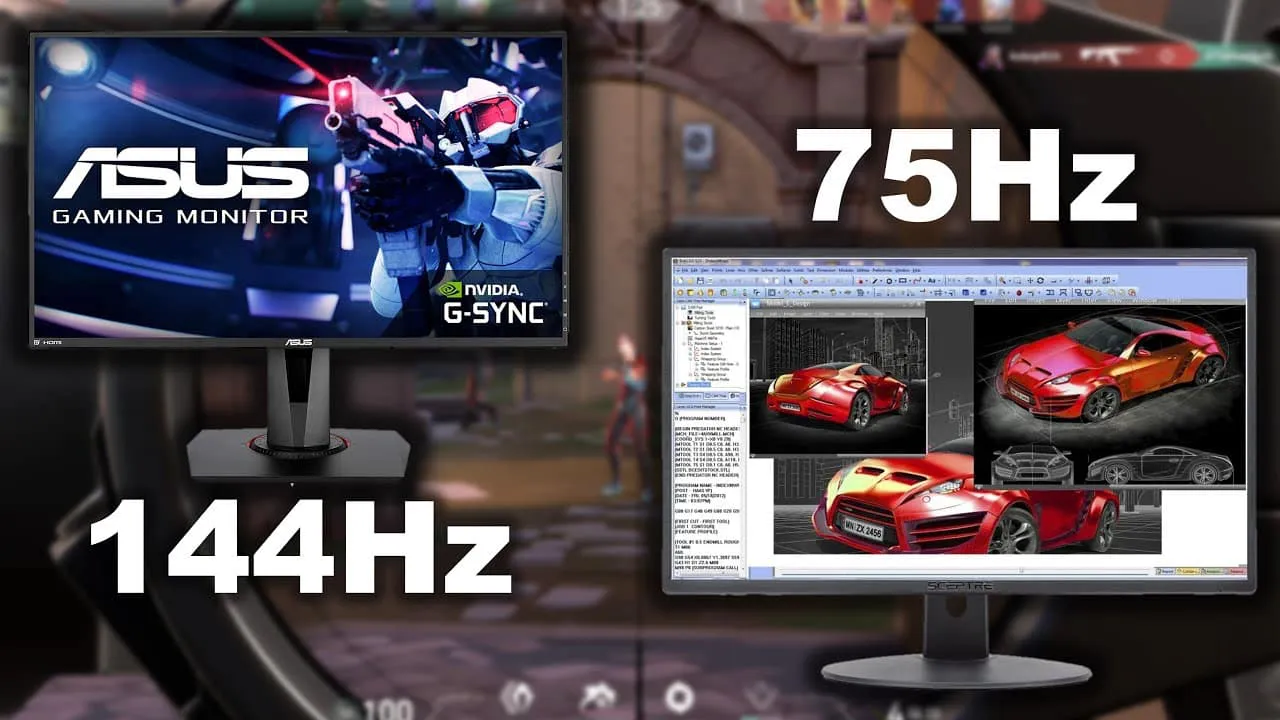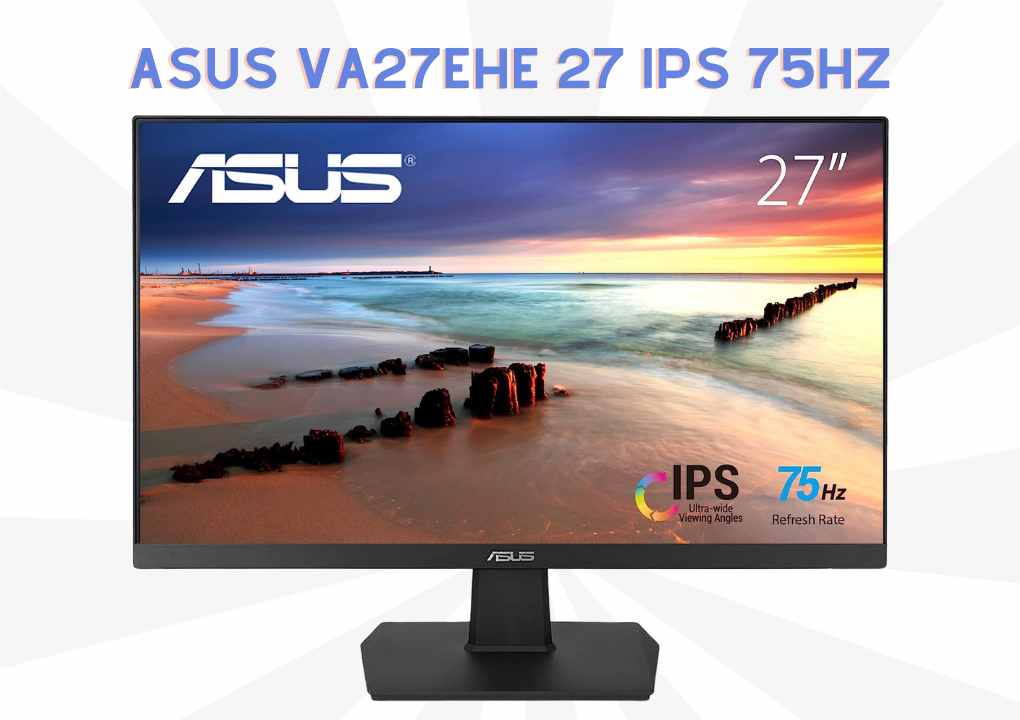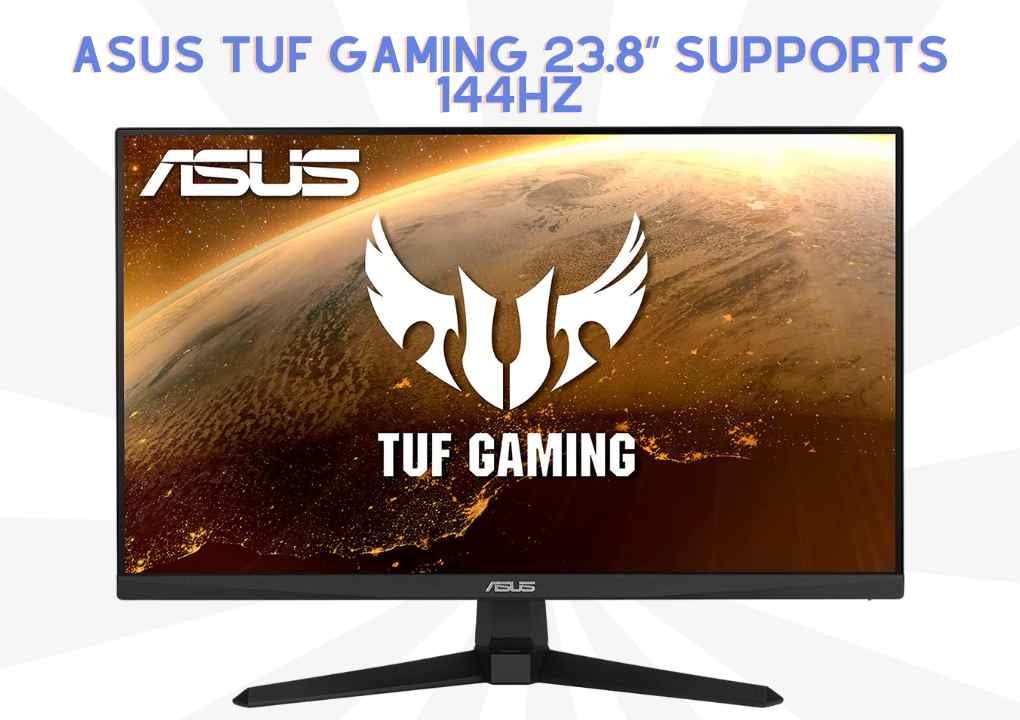75hz vs 144hz. What's best for Gaming in 2023?

Contents [Show]
Welcome to the exciting world of gaming and visual immersion, where we'll compare two essential terms: 75Hz and 144Hz refresh rates. The refresh rate determines how frequently the screen updates its image, which affects how smooth the motion appears. In this exploration, we'll uncover the differences between these refresh rates and their impact on gaming performance. By the end, you'll be equipped to decide strongly based on your preferences and needs. Let's dive in and discover the world of 75Hz vs 144Hz!
What is a Refresh Rate?
Refresh rate, measured in Hertz (Hz), is the heartbeat of your screen. It measures how often your display refreshes its image per second, like a painter's brushstrokes on a canvas. The higher the refresh rate, the more frequently your screen updates, resulting in a mesmerizing spectacle of smooth, fluid motion. It's like witnessing a breathtaking ballet performance, where every movement seamlessly flows into the next.
The refresh rate becomes even more crucial When indulging in fast-paced activities like gaming or watching action-packed videos. It's like adding turbo boosters to your experience, eliminating any hint of lag or blur. Suddenly, you're immersed in a world where every frame is razor-sharp, every movement is captured with precision, and the visuals come alive with a vibrant intensity.
How a refresh rate affects the visual experience
Like a conductor guiding an orchestra, the refresh rate profoundly influences your visual experience, orchestrating the harmony between your eyes and the screen. Let's explore how this magical parameter can transform your viewing adventure.
-
Smoother Motion: A higher refresh rate casts a spell on your visuals, bestowing them with a newfound grace and fluidity. As the screen refreshes more frequently, each frame seamlessly blends into the next, eliminating the choppiness and judder that can plague lower refresh rates. The result? Butter-smooth motion that glides effortlessly before your eyes, enhancing your immersion and leaving you spellbound.
-
Reduced Motion Blur: Reduce the ghostly trails that can appear behind fast-moving objects. A higher refresh rate can minimize motion blur by displaying more frames per second, resulting in sharper and clearer images during rapid action sequences. While other factors like pixel response time, frame rate, and eye movement also contribute to motion blur, a higher refresh rate significantly reduces its impact.
-
Enhanced Responsiveness: Imagine a world where your screen becomes an extension of your thoughts, instantly mirroring your actions with almost telepathic precision. A higher refresh rate grants you this superpower. With a faster update speed, the lag between your input and the corresponding on-screen reaction diminishes significantly. It's a realm where you feel truly connected, empowering you to unleash your full potential, whether gaming, editing or simply navigating through the digital realm.
-
Immersive Delight: Brace yourself for an immersive feast that tantalizes your senses. A higher refresh rate breathes life into your visuals, imbuing them with a vibrancy that transcends the ordinary. Colors become more vivid, textures gain depth, and the world on your screen pulsates with a newfound vitality. It's like stepping into a portal where reality blends with fantasy, enveloping you in a captivating embrace that leaves you craving more.
What is a 75Hz Monitor:
A 75Hz monitor is a display with a refresh rate of 75 times per second. It represents an upgrade from the standard 60Hz monitors and offers a slightly smoother visual experience. While not as high as some gaming-centric monitors, a 75Hz display still provides notable benefits over the traditional 60Hz counterparts.
Benefits of a 75Hz Monitor:
-
Smoother Motion: A 75Hz display has a higher refresh rate than a standard 60Hz monitor, which means it can display more frames per second. This can improve motion clarity and reduce judder or stuttering in some videos or activities with moderate motion. While the perceived smoothness can vary among users, the higher refresh rate offers the potential for a smoother visual experience.
-
Reduced Screen Tear: Screen tearing occurs when the graphic card and Monitor are out of sync it results in a visible horizontal line where the screen appears to split. A 75Hz monitor, with its increased refresh rate, can reduce screen tearing, providing a more seamless visual experience.
-
Enhanced Responsiveness: While not as responsive as higher refresh rates, a 75Hz monitor still slightly improves input lag compared to a 60Hz monitor. This can be beneficial in gaming or fast-paced tasks where even a small reduction in latency can make a difference.
-
Lower System Requirements: A 75Hz monitor is less demanding on system resources than higher refresh rate displays. It can be ideal for users with budget-friendly setups or those who want a smoother experience without needing a high-end graphics card.
-
Versatility: A 75Hz monitor balances smoothness and affordability, making it suitable for various uses. It can enhance the visual experience for gaming, casual multimedia consumption, general computer usage, and productivity tasks.
Best 75Hz Monitor?
ASUS VA27EHE 27 IPS 75Hz

Immerse yourself in a visual wonderland with the ASUS VA27EHE 27" Eye Care Monitor. Designed to elevate your viewing experience, this Monitor boasts a generous 27-inch IPS panel with Full HD (1920 x 1080) resolution, offering a wide 178° viewing angle and stunning image quality. Get captivated by vibrant colors, sharp details, and lifelike visuals that bring your content to life.
The ASUS VA27EHE continues beyond visuals alone. With a refresh rate of up to 75Hz and Adaptive-Sync technology, it ensures smooth, tear-free video playback. Say goodbye to annoying artifacts and motion blur as you enjoy your favorite movies, games, and videos with utmost clarity and precision. Every frame is delivered seamlessly, mesmerizing you with the fluidity and realism on the screen.
Specifications:
- Display Size: 27 inches
- Panel Type: IPS
- Resolution: Full HD (1920 x 1080)
- Viewing Angle: 178° (H) / 178° (V)
- Refresh Rate: Up to 75Hz
- Adaptive-Sync: Yes
Pros
- immersive 27-inch IPS panel
- Wide viewing angle for consistent colors
- Smooth and tear-free video playback with a refresh rate of up to 75Hz
Cons
- limited to 75Hz, not ideal for competitive gaming or fast-paced action
What is a 144Hz Monitor:
A 144Hz monitor is a display that boasts a refresh rate of 144 times per second, representing a significant upgrade from standard 60Hz monitors. This high refresh rate allows for smoother and more fluid motion, resulting in a more immersive and responsive visual experience. It has gained popularity among gamers and multimedia enthusiasts who crave the ultimate level of smoothness and clarity.
Benefits of a 144Hz Monitor:
-
Silky Smooth Motion: The foremost advantage of a 144Hz monitor is the exceptionally smooth and fluid motion. With a refresh rate almost two and a half times faster than a standard 60Hz display, each frame transitions seamlessly, eliminating choppiness and stuttering. Whether you're gaming, watching high-action movies, or engaging in graphic-intensive tasks, the visual experience becomes incredibly immersive and lifelike.
-
Reduced Motion Blur: The higher refresh rate of a 144Hz monitor significantly reduces motion blur, ensuring that fast-moving objects and scenes appear sharp and distinct. This is especially beneficial for gaming, where swift reaction times and precise visual details can differentiate victory and defeat. Enjoy the advantage of improved clarity and responsiveness in fast-paced gameplay.
-
Enhanced Responsiveness: A 144Hz monitor offers improved responsiveness and reduced input lag, making it an ideal choice for competitive gaming. The lower the input lag, the more closely the on-screen actions mirror your real-time inputs, resulting in a more accurate and reactive gaming experience. Stay ahead of the competition with quicker response times and seamless gameplay.
-
Fluid Camera Movements:A 144Hz monitor can display higher frame rates than standard monitors, resulting in smoother camera panning and more fluid transitions in some games or videos that support higher frame rates. However, it's important to note that most cinematic experiences are filmed or rendered at lower frame rates, such as 24fps or 30fps. A 144Hz monitor cannot make these frame rates smoother or more fluid than they are. It can only display them without judder or screen tearing if they are compatible with the Monitor's refresh rate or if adaptive sync technologies are enabled.
-
Future-Proofing: Investing in a 144Hz monitor offers a degree of future-proofing. As more advanced and demanding content emerges, such as virtual reality (VR) and high-refresh-rate gaming, a 144Hz display ensures compatibility and the ability to experience these technologies fully. It allows you to stay ahead of the curve and make the most of upcoming advancements.
Best 144Hz Monitor?
ASUS TUF Gaming 23.8 Supports 144Hz Moitor

Experience gaming like never before with the ASUS TUF Gaming 23.8" 1080P Monitor (VG247Q1A). Designed for the professional gamers and immersive gameplay experience, this Monitor boasts a 23.8-inch Full HD (1920 x 1080) display with an ultrafast 165Hz refresh rate (supports 144Hz). Get transported into a world of stunning visuals and ultra-smooth gameplay.
The ASUS VG247Q1A is equipped with ASUS Extreme Low Motion Blur (ELMB) technology, ensuring a lightning-fast 1ms response time (MPRT). Combined with Adaptive-sync, this Monitor eliminates ghosting, delivering sharp and precise gaming visuals even at high frame rates. Say goodbye to motion blur and enjoy every detail with remarkable clarity, giving you a competitive edge in fast-paced games.
Specifications:
- Display Size: 23.8 inches
- Resolution: Full HD (1920 x 1080)
- Refresh Rate: 165Hz (supports 144Hz)
- Response Time: 1ms (MPRT)
Pros
- Ultrafast refresh rate for incredibly smooth and immersive gameplay
- ASUS Extreme Low Motion Blur (ELMB) technology for a lightning-fast response time
- Broad compatibility with NVIDIA GeForce and AMD Radeon graphics cards
Cons
-
Limited to Full HD resolution, it may not be suitable for users requiring higher pixel density.
Benefits of Having a Higher Refresh Rate Monitor
-
Smoother and Fluid Motion: One of the primary benefits of having a higher refresh rate monitor is the ability to enjoy smoother and more fluid motion on the screen. A higher refresh rate, such as 144Hz or 240Hz, ensures the images transition seamlessly without noticeable lag or choppiness. Whether gaming, watching videos, or working with animations, the smoothness of motion enhances the overall visual experience and immersion.
-
Reduced Motion Blur: Higher refresh rate monitors also reduce motion blur. Motion blur occurs when fast-moving objects appear blurry or indistinct on the screen, causing a loss of clarity and detail. With a higher refresh rate, each frame is displayed for a shorter duration, reducing motion blur and crisper visuals, especially during fast-paced action sequences in games or high-motion video content.
-
Enhanced Responsiveness: A higher refresh rate monitor significantly improves responsiveness, making it an ideal choice for gaming and other tasks that require quick reaction times. With a higher refresh rate, the time between your input (such as moving the mouse or pressing a key) and the corresponding on-screen action is reduced. This reduced input lag provides a more immediate and satisfying response, resulting in a more immersive and competitive gaming experience.
-
Improved Visual Clarity: A higher refresh rate monitor enhances visual clarity, particularly during rapid movements. It helps to prevent screen tearing, which occurs when the Monitor's refresh rate and the graphics card's output are out of sync, resulting in visible horizontal lines or artifacts on the screen. With a higher refresh rate, screen tearing is minimized or eliminated, leading to a clearer and more cohesive visual presentation.
-
Gaming Advantage: Higher refresh rate monitors offer a significant advantage in gaming, particularly in fast-paced and competitive titles. Their smooth and responsive gameplay can give players a competitive edge, allowing for more accurate and precise aiming, tracking fast-moving objects, and reacting swiftly to in-game events. It enhances the overall gaming experience, making it more immersive and enjoyable.
-
Eye Comfort: Higher refresh rate monitors can contribute to eye comfort by displaying smoother and clearer motion, which reduces the need for excessive eye movement and focus adjustment. It'll help reduce eye strain and fatigue during prolonged use. Additionally, many models feature advanced technologies such as flicker-free displays, eliminating the subtle flickering that can cause eye irritation and headaches over time. Moreover, low blue light filters are often incorporated,
What is a difference between 75Hz and 144Hz Monitors
The Difference between 75Hz and 144Hz monitors lies in their refresh rates. A 144Hz monitor refreshes the image 144 times per second, while a 75Hz monitor refreshes it 75 times. Higher refresh rate of 144Hz Monitors offers smoother motion, reduced blur, and improved responsiveness, particularly for gaming and fast-paced activities. It provides a more visually immersive experience. However, a 75Hz monitor can still provide a satisfactory experience, especially for casual use or lower-spec systems. The choice depends on individual preferences and intended use.
- Refresh Rate: 144Hz offers a higher refresh rate compared to 75Hz.
- Motion Clarity: 144Hz provides better motion clarity and reduces blur.
- Responsiveness: 144Hz offers reduced input lag and improved responsiveness.
- Smoothness: 144Hz delivers smoother and more fluid motion compared to 75Hz.
- System Requirements: Running at 144Hz may require a more powerful graphics card than running at 75Hz.
75hz vs 144hz refresh rate comparison table
|
Aspect |
75Hz |
144Hz |
|
Refresh Rate |
75 times per second |
144 times per second |
|
Motion Clarity |
Moderate |
Enhanced |
|
Responsiveness |
Decent |
Improved |
|
Smoothness |
Good |
Excellent |
|
Gaming Advantage |
Limited |
Significant |
|
System Requirements |
Less demanding |
More demanding |
Which is Better? 75Hz or 144Hz
Determining which is better, 75Hz or 144Hz, depends on your needs and preferences.
A 144Hz monitor offers smoother motion and enhanced responsiveness, making it ideal for gaming and fast-paced activities. The higher refresh rate improves motion clarity and reduces blur, delivering a more immersive visual experience.
However, if you have a lower-spec system or engage in casual use, a 75Hz monitor can still provide a satisfactory experience. It offers decent smoothness and responsiveness, suitable for everyday tasks and less demanding activities.
Consider your budget, specific use cases, and personal preferences when deciding between the two. Evaluate whether the enhanced smoothness and responsiveness of a 144Hz monitor justify the higher cost and system requirements. Ultimately, choose the refresh rate that best suits your needs and provides an enjoyable viewing experience.
Frequently Asked Questions
-
Is 75Hz Good For Gaming?
While 75Hz can provide a satisfactory gaming experience, higher refresh rates like 144Hz are generally preferred for smoother gameplay and improved responsiveness.
-
Can you use a 75Hz monitor for gaming?
Yes, you can use a 75Hz monitor for gaming. It can handle most games, but higher refresh rates offer a more optimal gaming experience.
-
Does 75Hz increase FPS?
No, a monitor's refresh rate does not directly affect your game's FPS (Frames Per Second) output. However, a higher refresh rate can make the motion on the screen appear smoother and more fluid.
-
Is 75Hz better than 144Hz for work?
It depends on the nature of your work. For general office tasks, a 75Hz monitor is sufficient. However, if your work involves graphics-intensive tasks or requires precise motion rendering, a 144Hz monitor might offer a better experience.
-
Is 75Hz good for office work?
A 75Hz monitor is generally suitable for office work, providing a smooth display for regular tasks like document editing, web browsing, and email management.
-
Is 75Hz good for Valorant?
While a 75Hz monitor can run Valorant, a higher refresh rate, such as 144Hz, can provide a more responsive and smoother gaming experience, enhancing your gameplay performance.
Conclusion
In conclusion, choosing between a 75Hz and a 144Hz monitor depends on your specific needs and preferences. If you prioritize smoother motion, enhanced responsiveness, and optimal gaming performance, a 144Hz monitor is recommended. It delivers a more immersive and fluid visual experience, particularly during fast-paced activities like gaming or watching action-packed videos.
However, if you have a lower-spec system, engage in casual use, or require a monitor for regular office tasks, a 75Hz monitor can still provide a satisfactory experience. It offers decent smoothness and responsiveness for everyday use.


0 Comments